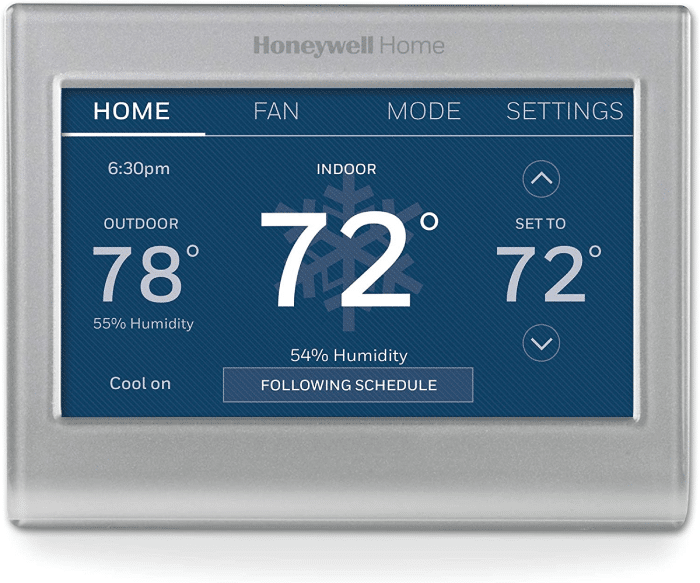We've independently reviewed this article to make sure it's as accurate as we can make it.
To find out more about our article creation and review process, check out our editorial guidelines.
Feeling unsure about the differences between Honeywell vs Nest smart thermostats?
You’re not alone! Choosing the right thermostat is crucial to make sure your home is always at the right temperature.
This is why we’ve created this comprehensive guide that will help you understand all about their differences.
Honeywell smart thermostats have a simple design but offer a more advanced interface, better temp control, and compatibility with multiple smart home systems. Nest offers a modern design, unique features, and varying prices, but may not be as effective at controlling the temperature.
Are you ready? Let’s dive in!
Nest vs Honeywell Smart Thermostats
When it comes to smart thermostats – there’s two titans of the industry. Google Nest, & Honeywell Smart Thermostats.
But, which one is better?
It depends on your needs! To help you make the right choice, in this section, we’ll compare both brands across 7 categories.
#1 Design
Since Honeywell Thermostats have upgraded to smart technology, the design still has room for improvement.
They’ve retained the traditional flat, square/rectangular look while incorporating touch control and better display. It’s a basic, easy-going design.
On the other hand, the Nests’ sleek circular design has won awards for good reason. The display is crisp, high-resolution, and goes to sleep when not in use.

With the Nest thermostat, you can also get multiple color options.
Even though it comes down to personal preference, I feel like the Nest does better when it comes to aesthetic appeal.
#2 Interface
The Honeywell thermostats have a more complex, smart-device-like interface.
They have a touch screen that allows you to access multiple settings. It also displays more information on-screen, such as temperature, humidity, date, and time.
Nest has taken a more simplified approach by eliminating the need for touchscreens. They use the dial-up or down option to change the temperature.
It also only displays the temperature and current HVAC status on-screen. All other settings can be accessed on your phone via the Nest or Google Home app.
While Nest might be reminiscent of the traditional thermostat interface, Honeywell has a more advanced interface, better suited to modern-day smartphone users.
#3 Compatibility
Honeywell has the advantage of its compatibility platform, and Nest too has worked on its programming for good compatibility.
The Nest thermostats are compatible with up to 95% of heating and cooling systems.
While Honeywell is a preferred thermostat among most users as they have no issues in terms of compatibility.
I’d say both of them rank well on this particular scale.
#4 Smart Home Integration
Because Honeywell does not have its own smart home program, it has taken multiple third parties on board.
It’s compatible with multiple smart home integration services such as Apple Homekit, Google Assistant, Amazon Alexa, Cortana and SmartThings.
However, Google’s Nest thermostat is currently only compatible with limited services such as Google Home and Amazon Alexa.
So if you’re in the market for a more diverse thermostat, opt for Honeywell.
#5 Program and Scheduling
Both Honeywell and Nest give you the option to schedule temperature changes. You can set times according to your preference.
They also use geofencing technology to sense your location via your smartphone. This feature allows it to turn off the heating/cooling while you’re away and turn it on when you’re approaching.
This helps save energy!
However, the Nest has the edge with its learning technology. It remembers your preferences and sets the temperature accordingly. It also adjusts settings according to your routine.
#6 Temperature Control
Honeywell boasts a tighter temperature regulation. It can keep your room’s temperature within 1–2 degrees of what you set.
This can be credited to its area coverage of up to 200ft. It can sync to its individual room sensors as well.
While Nest isn’t particularly bad on that front, it shows a wider difference in room temperature.
So if you’re someone that needs meticulous temperature control, Honeywell might be better suited for you.
#7 Price
Finally, let’s talk about their difference in price.
While both Honeywell and Nest are similar on the pricing scale, Nest offers a wider range of costs ($129 to $249). While most Honeywell thermostats are similarly priced around $200.
I feel like the Nest caters to a wider market demographic.
Honeywell WiFi Thermostat Models
Honeywell thermostats are well known for their ease of usage, making them a leading competitor in the market. Currently, Honeywell has three different types of offerings for smart thermostats. These are:
Honeywell Home T9 WIFI Smart Thermostat
This is a basic, entry-level smart thermostat that costs about $200.
It features an impressive colored LCD touch-screen display, allowing for up to 7-day scheduling. It has automatic temperature control and humidity-sensing properties.
The sensor works at an extensive area of up to 200 ft.

It can be controlled via your smartphone through the Honeywell app. It also works with smart home devices such as Google Home, Amazon Alexa, Samsung SmartThings, and more.
Other specifications include:
- Geofencing
- Additional support for up to 20 sensors
- Room prioritization
- Frost alerts
- Filter change alerts
- 4-wire configuration
- 2-year warranty
Honeywell RTH9585WF1004 Wi-Fi Smart Color 7-Day Programmable Thermostat
This model also features a colored touch-screen display that also shows you the daily forecast on-screen.
Its smart response technology allows for precise temperature control. It also has automatic energy-saving settings. These can be easily accessed and changed in case of vacations or other temporary holdouts.

You can use password-protect if you prefer.
If confused, you can simply use the on-screen help button to answer any questions.
It can be controlled via the Honeywell app through Amazon Alexa, SmartThings, and Google Home. It’s slightly more expensive, being priced at $219.
Other features include:
- Energy-star certified
- Compatible with heating and cooling pumps
- Learns preferred heating and cooling cycle times
- 1-year limited warranty
Honeywell Lyric T5 Wi-Fi Smart Thermostat – RCHT8610WF2006
Using geofencing technology, this smart thermostat senses your location. It uses it to adjust the temperature to your preferred settings. This way you can come home to an environment you like.
It has an intelligent comfort control that automatically determines if you need more cooling or heating. The device also allows 7-day scheduling along with custom fan settings.

It can be controlled via the Honeywell App on your smartphone. Or through Amazon Alexa, Google Assistant, Apple HomeKit, IFTTT, and Cortana.
Other notable specs include:
- Multistage heating/cooling
- Furnace function
- Central Air Conditioning
- Energy-star certified
Nest Thermostat Models
Nest Thermostats boast energy-efficiency and geofencing. They have the added convenience of remotely controlling the appliance via your WiFi-operated device.
Nest Thermostats currently come in two different variants, which include:
Nest Thermostat
Priced at $129, this is a more basic variant of the company’s smart thermostat.
It has a plastic body and mirror display and it’s available in four different colors. It is compatible with 85% of 24V heating and cooling systems.

This nest thermostat can be controlled via the Google Home app on your phone or through voice control via the Google Home device.
Some other features include:
- Easy setup
- System monitoring and automatic alerts
- 1-year warranty
Nest Learning Thermostat
Being the more advanced model of the two of Google’s thermostats, this one is significantly more expensive being priced at $249.
With its metal ring design and high-resolution farsight display, this variant boasts aesthetic appeal in comparison to its counterpart.

However, the main difference in terms of functionality is this model’s ability to learn your temperature preferences. It adapts to your usage and schedules the temperature accordingly.
You can also do it manually as well or through the Nest App on your smartphone.
Other features I noticed were:
- A 95% compatibility rate
- Works with the Nest temperature sensor (available separately)
- 6 different color options
- 2-year warranty
Which One’s Better For Who
Both thermostats stand strong in terms of functionality and design. However, it can be confusing to figure out which one is better.
If you’re interested in smart control and a minimalist, sleek design- you might like the Google Nest Smart thermostats better.
The company was one of the first to come up with smart thermostats. They have stuck around since then for a reason.
A lot of people like that they’ve eliminated needless displays and simplified controls via the radial dial.
However, if you’re ready to compromise on aesthetics, you might prefer the Honeywell thermostats!
Conclusion
And alas, we arrive at the final verdict!
It’s difficult to decide which thermostat actually stands as the Winner.
Honeywell thermostats are better in terms of temperature control. They have an all-in-one device interface that a lot of people prefer. I found them to also be more reliable, credited to their long experience in the market. However, they lack the sleek, minimalistic design preferred by modern-day users.
Nest thermostats are more suited to modern-day aesthetics. They offer advanced features such as the “learning” ability. It adjusts settings according to your preferences and routine. Also, Nest thermostats have the ability to sense movement and turn off if there’s no movement detected.
But for the sake of this article, I’d opt for the Honeywell Smart Thermostats as my final pick!
They offer you smart-technology integration along with being reliable. It’s the best of both worlds!
If you found this article helpful, do check out other similar articles on our site.
Thanks a lot for reading, and have a great day!
-Craig







